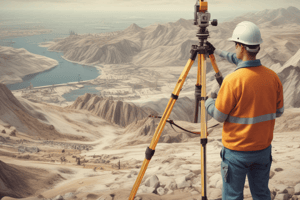Podcast
Questions and Answers
What is the primary role of civil engineers in society?
What is the primary role of civil engineers in society?
- Ensuring the structural integrity of buildings and infrastructure (correct)
- Maintaining ecological balance in nature
- Designing machinery for manufacturing
- Regulating transportation systems
Which discipline focuses on the management and treatment of water resources?
Which discipline focuses on the management and treatment of water resources?
- Geo-technical Engineering
- Transportation Engineering
- Structural Engineering
- Hydraulics and Water Resources Engineering (correct)
What is a common technique introduced in prefabricated construction?
What is a common technique introduced in prefabricated construction?
- Modular component assembly (correct)
- Use of traditional building materials
- On-site construction with raw materials
- Concrete pouring in situ
Which of the following measuring techniques is used in surveying to determine horizontal distances?
Which of the following measuring techniques is used in surveying to determine horizontal distances?
What is the primary advantage of using flexible pavements over rigid pavements?
What is the primary advantage of using flexible pavements over rigid pavements?
What is a key function of levelling instruments in surveying?
What is a key function of levelling instruments in surveying?
What role do transportation systems play in a nation's economy?
What role do transportation systems play in a nation's economy?
Which water-related structure is primarily designed to store water?
Which water-related structure is primarily designed to store water?
Which of the following is not a characteristic of prefabricated technology?
Which of the following is not a characteristic of prefabricated technology?
Which engineering discipline is primarily concerned with the characteristics of civil engineering materials?
Which engineering discipline is primarily concerned with the characteristics of civil engineering materials?
Flashcards
Civil Engineering
Civil Engineering
The branch of engineering that deals with the design, construction, and maintenance of physical and naturally built environments, including public works, infrastructure, and buildings.
Structural Engineering
Structural Engineering
Focuses on the analysis, design, and construction of structures like buildings, bridges, and towers, ensuring their stability and safety.
Geotechnical Engineering
Geotechnical Engineering
Deals with the behavior of Earth materials, such as soil and rock, in relation to construction projects.
Transportation Engineering
Transportation Engineering
Signup and view all the flashcards
Hydraulics and Water Resources Engineering
Hydraulics and Water Resources Engineering
Signup and view all the flashcards
Environmental Engineering
Environmental Engineering
Signup and view all the flashcards
Surveying
Surveying
Signup and view all the flashcards
Bearing
Bearing
Signup and view all the flashcards
Flexible Pavement
Flexible Pavement
Signup and view all the flashcards
Rigid Pavement
Rigid Pavement
Signup and view all the flashcards
Study Notes
Course Outcomes
- Students will be able to understand the various sub-divisions of civil engineering and their roles in society
- Students will understand surveying concepts and measurements of distances, angles, and levels
- Students will appreciate the importance of transportation in the nation's economy
- Students will grasp the importance of water storage and conveyance structures for water conservation
- Students will have knowledge of civil engineering materials and prefabricated technology
Unit I - Basics of Civil Engineering
- Civil engineers' roles in society
- Civil engineering disciplines (structural, geo-technical, transportation, hydraulics, water resources, environmental)
- Scope of each discipline
- Building construction and planning
- Construction materials (cement, aggregate, bricks, concrete, steel)
- Prefabricated construction techniques
Unit II - Surveying
- Surveying objectives
- Horizontal measurements
- Angular measurements
- Levelling instruments
- Simple problems on levelling and bearings
- Contour mapping
Unit III - Transportation Engineering
- Importance of transportation in economic development
- Types of highway pavements: flexible and rigid
- Differences between flexible and rigid pavements
- Basics of harbour, tunnel, airport, and railway engineering
Textbooks
- Basic Civil Engineering by M.S. Palanisamy
- Introduction to Civil Engineering by S.S. Bhavikatti
- Basic Civil Engineering by Satheesh Gopi
Reference Books
- Surveying by S.K. Duggal
- Hydrology and Water Resources Engineering by Santosh Kumar Garg
- Irrigation Engineering and Hydraulic Structures by Santosh Kumar Garg
- Highway Engineering by C.E.G. Justo, Veeraraghavan, K. Khanna
- Indian Standard Drinking Water Specifications (IS 10500-201)
Studying That Suits You
Use AI to generate personalized quizzes and flashcards to suit your learning preferences.




